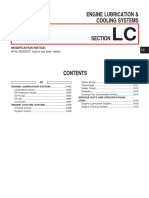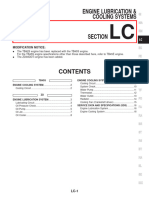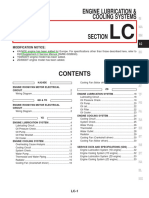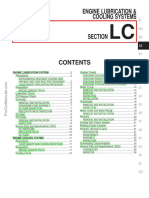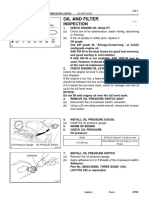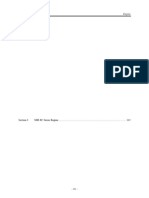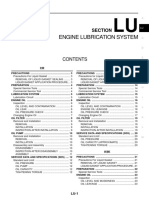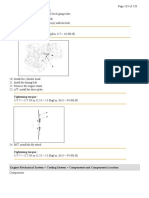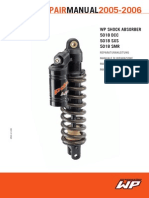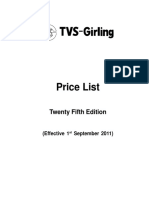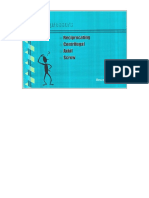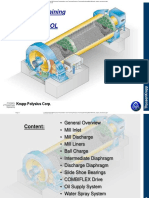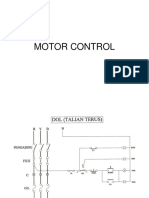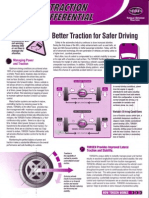ENGINE LUBRICATION &
COOLING SYSTEMS
SECTION LC
LC
CONTENTS
PRECAUTIONS AND PREPARATION............................1 System Check..............................................................9
Liquid Gasket Application Procedure ..........................1 Water Pump ...............................................................10
Special Service Tools ..................................................2 Thermostat.................................................................12
ENGINE LUBRICATION SYSTEM ..................................3 Radiator .....................................................................14
Lubrication Circuit ........................................................3 Refilling Engine Coolant ............................................14
Oil Pressure Check......................................................3 Cooling Fan (Crankshaft driven) ...............................15
Oil Pump ......................................................................4 Cooling Fan (Motor driven)........................................15
Oil Cooler.....................................................................7 Radiator (Aluminum type)..........................................16
Oil Jet...........................................................................7 Overheating Cause Analysis .....................................20
Turbocharger ...............................................................8 SERVICE DATA AND SPECIFICATIONS (SDS) ..........21
ENGINE COOLING SYSTEM..........................................9 Engine Lubrication System........................................21
Cooling Circuit .............................................................9 Engine Cooling System .............................................21
�PRECAUTIONS AND PREPARATION
Liquid Gasket Application Procedure
a. Use a scraper to remove all traces of old liquid gasket from
mating surfaces and grooves. Also, completely clean any oil
from these areas.
b. Apply a continuous bead of liquid gasket to mating surfaces.
(Use Genuine Liquid Gasket or equivalent.)
+ For oil pan, be sure liquid gasket diameter is 3.5 to 4.5 mm
(0.138 to 0.177 in).
+ For areas except oil pan, be sure liquid gasket diameter is
2.0 to 3.0 mm (0.079 to 0.118 in).
SEM164F c. Apply liquid gasket around the inner side of bolt holes (unless
otherwise specified).
d. Assembly should be done within 5 minutes after coating.
e. Wait at least 30 minutes before refilling engine oil and engine
coolant.
AEM080
LC-1
� PRECAUTIONS AND PREPARATION
Special Service Tools
*: Special tool or commercial equivalent
Tool number
Description
Tool name
ST25051001* Measuring oil pressure
Oil pressure gauge
Maximum measuring range:
2,452 kPa (24.5 bar, 25
kg/cm2, 356 psi)
NT558
ST25052000* Adapting oil pressure gauge
Hose to cylinder block
NT559
EG17650301 Adapting radiator cap tester
Radiator cap tester to radiator filler neck
adapter
a: 28 (1.10) dia.
b: 31.4 (1.236) dia.
c: 41.3 (1.626) dia.
NT564 Unit: mm (in)
KV99103510 Installing radiator upper and
Radiator plate pliers A lower tanks
NT224
KV99103520 Removing radiator upper and
Radiator plate pliers B lower tanks
NT225
WS39930000 Pressing the tube of liquid gas-
Tube presser ket
NT052
LC-2
�ENGINE LUBRICATION SYSTEM
Lubrication Circuit
SLC201B
Oil Pressure Check
WARNING:
+ Be careful not to burn yourself, as the engine and oil may
be hot.
+ Oil pressure check should be done in ‘‘Neutral’’ gear posi-
tion.
SLC694A
1. Check oil level.
2. Remove oil pressure switch.
SLC194B
LC-3
�ENGINE LUBRICATION SYSTEM
Oil Pressure Check (Cont’d)
3. Install pressure gauge.
4. Start engine and warm it up to normal operating temperature.
5. Check oil pressure with engine running under no-load.
Engine Approximate discharge pressure
rpm kPa (bar, kg/cm2, psi)
More than 78 (0.78, 0.8, 11)
Idle speed
318.7 - 424.6
3,000
(3.19 - 4.25, 3.25 - 4.33, 46.2 - 61.6)
If difference is extreme, check oil passage and oil pump for oil
SLC993 leaks.
6. Install oil pressure switch with sealant.
Use proper liquid sealant.
Oil pressure switch:
: 10 - 16 Nzm (1.0 - 1.6 kg-m, 87 - 139 in-lb)
Oil Pump
REMOVAL AND INSTALLATION
1. Disconnect battery terminal.
2. Drain engine oil.
3. Drain coolant from radiator and cylinder block. Refer to MA
section (‘‘Changing Engine Coolant’’, ‘‘ENGINE MAINTE-
NANCE’’).
4. Remove radiator shroud.
5. Remove drive belts. Refer to MA section (‘‘Checking Drive
Belts’’).
6. Remove crankshaft pulley and front upper and lower belt cov-
ers. Refer to EM section (‘‘TIMING BELT’’).
7. Remove oil pan. Refer to EM section (‘‘OIL PAN’’).
8. Remove oil strainer.
9. Remove oil pump assembly.
10. Installation is in reverse order of removal.
+ Before installing oil pump, remove liquid gasket from mating
surface of oil pump using a scraper.
Be sure liquid gasket in grooves is also removed.
+ Remove liquid gasket from mating surface of cylinder block.
+ Clean all traces of liquid gasket using white gasoline.
LC-4
�ENGINE LUBRICATION SYSTEM
Oil Pump (Cont’d)
SLC195B
REGULATOR VALVE INSPECTION
1. Visually inspect components for wear and damage.
2. Check oil pressure regulator valve sliding surface and valve
spring.
3. Coat regulator valve with engine oil and check to make sure
that it falls smoothly into the valve hole by its own weight.
If damaged, replace regulator valve set or oil pump assembly.
SLC295
OIL PRESSURE RELIEF VALVE INSPECTION
Inspect oil pressure relief valve for movement, cracks and breaks
by pushing the ball. If replacement is necessary, remove valve by
prying it out with a screwdriver.
Install a new valve in place by tapping it.
SLC994
LC-5
�ENGINE LUBRICATION SYSTEM
Oil Pump (Cont’d)
OIL PUMP INSPECTION
Using a feeler gauge, check the following clearance.
Unit: mm (in)
Body to outer gear clearance 1
V 0.11 - 0.20 (0.0043 - 0.0079)
Inner gear to crescent clearanceV 2 0.216 - 0.326 (0.0085 - 0.0128)
Outer gear to crescent clearance V 3 0.21 - 0.32 (0.0083 - 0.0126)
Housing to inner gear clearance V4 0.05 - 0.09 (0.0020 - 0.0035)
Housing to outer gear clearance V5 0.05 - 0.11 (0.0020 - 0.0043)
SLC779 Inner gear to brazed portion of housing
0.106 - 0.152 (0.0042 - 0.0060)
clearance V 6 =A− B
If it exceeds the limit, replace gear set or entire oil pump
assembly.
SLC780
SLC015A
SLC016A
LC-6
�ENGINE LUBRICATION SYSTEM
Oil Cooler
REMOVAL AND INSTALLATION
SLC196B
Install oil cooler as shown in the figure.
INSPECTION
1. Check oil cooler element and bracket for cracks.
2. Check coolant inlet of oil cooler for clogging by blowing through
it. Replace it if necessary.
Oil Jet
INSPECTION
1. Push cut-off valve of oil jet bolt with a clean resin or brass rod
and make sure that cut-off valve moves smoothly with proper
repulsion.
2. Make sure that the oil jet passage is not clogged. Clean with a
wire if necessary.
SLC015
LC-7
�ENGINE LUBRICATION SYSTEM
Oil Jet (Cont’d)
When installing oil jet, align oil jet’s boss with hole on cylin-
der block.
Oil jet bolt:
: 30 - 40 Nzm (3.1 - 4.1 kg-m, 22 - 30 ft-lb)
SLC975
Turbocharger
SLC197B
+ Before removing water tube, drain coolant first.
+ Be careful not to deform tubes.
+ After installation, run engine for a few minutes, and check
for oil leakage.
LC-8
� ENGINE COOLING SYSTEM
Cooling Circuit
SLC226A
System Check
WARNING:
Never remove the radiator cap when the engine is hot; serious
burns could be caused by high pressure fluid escaping from
the radiator.
Wrap a thick cloth around cap and carefully loosen it a quar-
ter turn to release built-up pressure. Then remove the cap
completely.
CHECKING COOLING SYSTEM HOSES
Check hoses for proper attachment, leaks, cracks, damage, loose
connections, chafing and deterioration.
CHECKING RADIATOR CAP
Apply pressure to radiator cap by means of a cap tester to see if it
is satisfactory.
Radiator cap relief pressure:
78 - 98 kPa
(0.78 - 0.98 bar, 0.8 - 1.0 kg/cm2, 11 - 14 psi)
SLC613
LC-9
� ENGINE COOLING SYSTEM
System Check (Cont’d)
Pull the negative pressure valve to open it. Check that it closes
completely when released.
SMA967B
CHECKING COOLING SYSTEM FOR LEAKS
Apply pressure to the cooling system by means of a tester to check
for leakage.
Testing pressure:
98 kPa (0.98 bar, 1.0 kg/cm2, 14 psi)
CAUTION:
Use of pressure higher than the specified value may cause
damage to radiator.
SMA007D
Water Pump
CAUTION:
+ When removing water pump assembly, be careful not to
get coolant on drive belts.
+ Water pump cannot be disassembled and should be
replaced as a unit.
+ After installing water pump, connect hose and clamp
securely, then check for leaks using radiator cap tester.
REMOVAL
1. Drain coolant from radiator and cylinder block.
Cylinder block drain plug (Use proper sealant):
: 34 - 44 Nzm (3.5 - 4.5 kg-m, 25 - 33 ft-lb)
Refer to MA section (‘‘Changing Engine Coolant’’, ‘‘ENGINE
MAINTENANCE’’).
2. Remove radiator shroud.
3. Remove drive belts. Refer to MA section (‘‘Checking Drive
Belts’’).
4. Remove fan coupling with fan.
SMA003D 5. Remove water pump.
LC-10
� ENGINE COOLING SYSTEM
Water Pump (Cont’d)
SLC997-A
INSPECTION
1. Check for rusted or corroded body assembly and vane.
2. Check for excessive end play and rough operation.
INSTALLATION
+ Remove liquid gasket from mating surface of pump housing
using a scraper.
Be sure liquid gasket in grooves is also removed.
+ Remove liquid gasket from mating surface of cylinder block.
+ Clean all traces of liquid gasket using white gasoline.
SLC998
+ Cut off tip of nozzle of liquid gasket tube at point shown in fig-
ure.
+ Use Genuine Liquid Gasket or equivalent.
SLC822
LC-11
� ENGINE COOLING SYSTEM
Water Pump (Cont’d)
+ Apply a continuous bead of liquid gasket to mating surface of
pump housing as shown.
a. Be sure diameter of liquid gasket is within 2.0 to 3.0 mm
(0.079 to 0.118 in) dia. range.
b. Attach pump housing to cylinder block within five minutes
of applying liquid gasket.
c. After installing pump housing, wait at least 30 minutes
before starting engine.
SLC001A
Thermostat
SLC002A
INSPECTION
1. Check valve seating condition at ordinary temperatures. It
should seat tightly.
2. Check valve opening temperature and maximum valve lift.
Valve opening temperature C° (°F) 82.0 (180)
Maximum valve lift mm/°C (in/°F) 10/90 (0.39/194)
3. Then check if valve closes at 5°C (9°F) below valve opening
temperature.
SLC343
INSTALLATION
+ Remove liquid gasket from mating surface of thermostat using
a scraper.
+ Similarly, remove liquid gasket from mating surface of cylinder
block.
+ Clean all traces of liquid gasket using white gasoline.
Scraper
SLC790
LC-12
� ENGINE COOLING SYSTEM
Thermostat (Cont’d)
+ Cut off tip of nozzle of liquid gasket at point shown in figure.
+ Use Genuine Liquid Gasket or equivalent.
SLC822
Diameter of liquid gasket: + Apply a continuous bead of liquid gasket to mating surface of
2.0 - 3.0 mm (0.079 - 0.118 in) water inlet.
a. Be sure diameter of liquid gasket is within 2.0 to 3.0 mm (0.079
to 0.118 in).
b. Attach water inlet to cylinder block within five minutes after
applying liquid gasket.
c. After installing water inlet, wait at least 30 minutes before refill-
ing coolant and starting engine.
SLC824
LC-13
�ENGINE COOLING SYSTEM
Radiator
REMOVAL AND INSTALLATION
1. Remove under cover.
2. Drain coolant from radiator drain plug.
3. Disconnect radiator upper and lower hoses.
4. Remove radiator lower shroud.
5. Disconnect reservoir tank hose.
6. Remove radiator.
7. After repairing or replacing radiator, install any part removed in
reverse order of removal.
SLC198B
Refilling Engine Coolant
For details on refilling engine coolant, refer to MA section (‘‘REFILL-
ING ENGINE COOLANT’’, ‘‘Changing Engine Coolant’’).
LC-14
� ENGINE COOLING SYSTEM
Cooling Fan (Crankshaft driven)
DISASSEMBLY AND INSTALLATION
+ Do not release the drive belt tension by removing the fan/water
pump pulley.
+ Fan coupling cannot be disassembled and should be replaced
as a unit. If front mark j F is present, install fan so that side
marked j F faces the front.
+ Install the drive belt only after the fan and fan coupling to water
pump flange bolts/nuts have been properly torqued.
+ Proper alignment of these components is essential. Improper
SLC176B
alignment will cause them to wobble and may eventually cause
the fan to separate from the water pump causing extensive
damage.
INSPECTION
Check fan coupling for damage, oil leakage and bent bimetal.
SLC072
Cooling Fan (Motor driven)
Cooling fan is controlled by ECM. For details, refer to ‘‘Cooling
Fan’’, ‘‘TROUBLE DIAGNOSIS FOR DTC 28’’ in EC section.
SLC177B
LC-15
� ENGINE COOLING SYSTEM
Radiator (Aluminum type)
SLC882AB
Aluminum radiator can be disassembled by using special proce-
dures and special service tools.
DISASSEMBLY
1. Remove tank with Tool.
SLC903
+ Grip the crimped edge and bend it upwards so that Tool slips
off.
Do not bend excessively.
SLC893
LC-16
� ENGINE COOLING SYSTEM
Radiator (Aluminum type) (Cont’d)
+ In areas where Tool cannot be used, use a screwdriver to bend
the edge up.
Be careful not to damage tank.
SLC908A
2. Make sure the edge stands straight up.
3. Remove oil cooler from tank. (A/T model only)
SLC931
ASSEMBLY
1. Install oil cooler.
Pay attention to direction of conical washer.
SLC894
2. Clean contact portion of tank.
SLC932
3. Install sealing rubber.
Push it in with fingers.
Be careful not to twist sealing rubber.
SLC917A
LC-17
� ENGINE COOLING SYSTEM
Radiator (Aluminum type) (Cont’d)
4. Caulk tank in specified sequence with Tool.
SLC904
SLC896
+ Use pliers in the locations where Tool cannot be used.
SLC897
5. Make sure that the rim is completely crimped down.
Standard height ‘‘H’’:
10.0 - 11.0 mm (0.394 - 0.433 in)
6. Confirm that there is no leakage.
Refer to Inspection.
SLC554A
LC-18
� ENGINE COOLING SYSTEM
Radiator (Aluminum type) (Cont’d)
INSPECTION
1. Apply pressure with Tool.
Specified pressure value:
98 kPa (0.98 bar, 1.0 kg/cm2, 14 psi)
WARNING:
To prevent the risk of the hose coming undone while under
pressure, securely fasten it down with a hose clamp.
Attach a hose to the oil cooler as well.
SLC933
2. Check for leakage.
SLC934
LC-19
� ENGINE COOLING SYSTEM
Overheating Cause Analysis
Symptom Check items
Water pump malfunction Worn or loose drive belt
Thermostat stuck closed —
Dust contamination or paper
Poor heat transfer Damaged fins clogging —
Mechanical damage
Excess foreign material (rust,
Clogged radiator cooling tube
dirt, sand, etc.)
Cooling fan does not operate
Fan coupling does not operate
Reduced air flow — —
High resistance to fan rotation
Damaged fan blades
Damaged radiator shroud — — —
Improper coolant mixture ratio — — —
Cooling
system parts Poor coolant quality — — —
malfunction
Loose clamp
Cooling hose
Cracked hose
Water pump Poor sealing
Loose
Radiator cap
Poor sealing
Coolant leaks
O-ring for damage, deteriora-
Insufficient coolant tion or improper fitting
Radiator
Cracked radiator tank
Cracked radiator core
Reservoir tank Cracked reservoir tank
Cylinder head deterioration
Exhaust gas leaks into cooling
Overflowing reservoir tank Cylinder head gasket deteriora-
system
tion
High engine rpm under no load
Driving in low gear for extended
Abusive driving
time
Driving at extremely high speed
— Overload on engine Powertrain system malfunction
Installed improper size wheels
and tires —
Except
Dragging brakes
cooling
system parts Improper ignition timing
malfunction
Blocked bumper —
Installed car brassiere
Blocked radiator grille Mud contamination or paper
Blocked or restricted air flow clogging —
Blocked radiator —
Blocked condenser
—
Installed large fog lamp
LC-20
� SERVICE DATA AND SPECIFICATIONS (SDS)
Engine Lubrication System
Oil pressure check Oil pump Unit: mm (in)
Engine Approximate discharge pressure Body to outer gear clearance
0.11 - 0.20 (0.0043 - 0.0079)
1
V
rpm kPa (bar, kg/cm2, psi)
More than 78 (0.78, 0.8, 11) Inner gear to crescent
Idle speed 0.216 - 0.326 (0.0085 - 0.0128)
318.7 - 424.6 clearance V 2
3,000
(3.19 - 4.25, 3.25 - 4.33, 46.2 - 61.6) Outer gear to crescent
0.21 - 0.32 (0.0083 - 0.0126)
clearance V3
Housing to inner gear
0.05 - 0.09 (0.0020 - 0.0035)
clearance V4
Housing to outer gear
0.05 - 0.11 (0.0020 - 0.0043)
clearance V5
Inner gear to brazed portion
0.106 - 0.152 (0.0042 - 0.0060)
of housing clearance V6
Engine Cooling System
Thermostat Radiator Unit: kPa (bar, kg/cm2, psi)
Valve opening temperature C° (°F) 82.0 (180) 78 - 98
Cap relief pressure
Maximum valve lift mm/°C (in/°F) 10/95 (0.39/203) (0.78 - 0.98, 0.8 - 1.0, 11 - 14)
Leakage test pressure 157 (1.57, 1.6, 23)
LC-21


